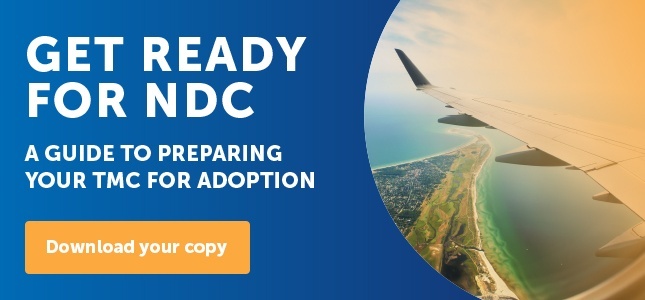
Recently we’ve talked a lot about how TMCs can ready themselves for the New Distribution Capability (NDC) standard and what it means for the wider travel industry. But what are the benefits, for your business and your customers, of adopting the standard?
What’s in it for TMCs?
In a nutshell, the advantages to TMCs of adopting the NDC can be condensed to 4 key points:
- Gaining valuable information to provide a personalised or tailored service to travellers: NDC adoption makes customers' travel history and preferences more accessible to TMCs. This allows TMCs to provide details regarding products relevant to each individual traveller, adding real value and offering oppportunities for increased revenue through the sale of ancillary products.
- The ability to provide real-time pricing, product and policy comparison to travellers: Allowing TMCs to base their offering upon products and services rather than just price. Again, creating an offering which gets to the heart of what each individual customer requires from their travel package.
- Providing an “Amazon Style” shopping experience for customers: The crux of which is customer choice and personalisation, whether that’s how to book, or the ability to include add-ons such as insurance, extra leg room on flights or even dietary requirements. Making it less likely that travellers will book ancillary products direct with the airline.
- Becoming better equipped to address the limitations of the current consumer environment: such as product variety, time to market and customer access to desired content. Aiding TMCs' differentiation and ability to provide product innovation.
Simply put, NDC gives TMCs increased transparency of travellers’ total spend. Instead of travel managers having access to just the fare cost ,with the traveller then individually booking ancillary products elsewhere, NDC allows the entire cost of a flight to be captured within the original booking.
The benefits of this are twofold: firstly, it helps to ease the commercial pressure upon TMCs from the direct channel. This is particularly important in light of a recent report by Atmosphere Research Group which estimates that airlines will grow their direct share from 33% in 2016 to 45% by 2021.
Although it's worth noting that the highest face value transactions (we estimate approximately 40% higher on average) such as corporate and long haul travel with complex itineraries, currently tend towards the indirect channel (and TMCs). Adopting NDC helps TMCs consolidate their postion and gives them a better shot at winning the business in the first place
Secondly, a simplified user experience should attract more customers to TMCs who adopt the standard, increasing sales and revenue. In fact, research by the Atmosphere Group predicts that TMCs will grow their market share by 6% by 2021, largely off the back of NDC.
What about GDSs?
Some industry heads view the NDC as an alternative to GDS, putting GDS developers and the systems themselves, at risk of becoming irrelevant as airlines and providers go directly to travel agents. However, we feel this is a little pessimistic: the level of complexity required for a direct connection between travel agents and airlines to operate efficiently would place an unnecessary burden on travel agencies and distract from core activities
In fact, the NDC is likely to benefit GDSs. As the development of the NDC is likely to make the airline distribution industry more complex, rather than simplifying it. This is a big win for GDSs, as the more complex distribution is, the greater the need for aggregators to collect and display the information, putting GDSs firmly in the driver’s seat.
GDSs still have a vital role to play in the airline distribution industry, and rather than fading into obscurity as some have suggested, it’s far more likely they’ll continue to evolve with the industry. As they evolved from the "lazy susans" that birthed them back in the 1950s.
Where next for TMCs?
Like the rest of the industry, we’re keenly waiting to see what will happen next with the NDC. We’ve high hopes that, as adoption increases, it will bring about positive change in the industry and consequently a better customer experience for travellers.
For an in-depth look at how OTAs and TMCs can prepare for NDC adoption, as well as a closer examination of what it means for the industry, download our guide to preparing your TMC for adoption.

